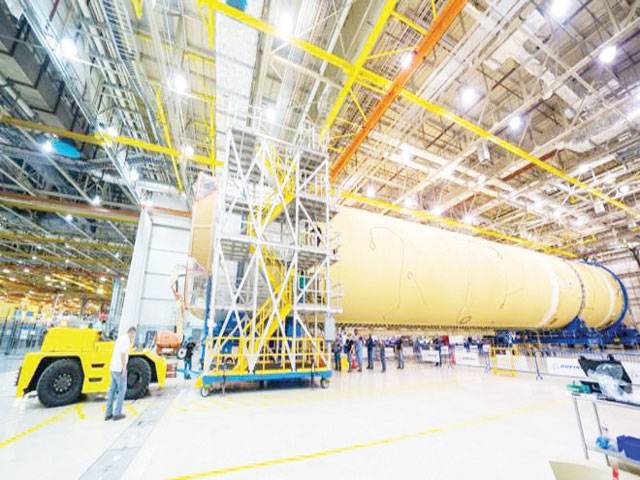US-Nasa has finished assembling the main structural components for its largest rocket since the Apollo-era Saturn V.
Engineers at the agency’s Michoud Assembly Facility (MAF) in New Orleans connected the last of five sections that make up the core of the Space Launch System (SLS).
The rocket will be used to send an uncrewed Orion craft to the Moon, in a flight expected to launch in 2021.
This will pave the way for crewed missions, with a landing in 2024.The last piece of the SLS’ 64m (212ft) -tall core stage was the complicated engine section. This will serve as the attachment point for the four powerful RS-25 engines, which are capable of producing two million pounds of thrust.
The RS-25 engines, built by Sacramento, California-based Aerojet Rocketdyne, are the same ones that powered the now-retired space shuttle orbiter.
Julie Bassler, Nasa’s SLS stages manager, said: “Now, to complete the stage, Nasa will add the four RS-25 engines and complete the final integrated avionics (electronics) and propulsion functional tests.
“This is an exciting time as we finish the first-time production of the complex core stage that will provide the power to send the Artemis 1 mission to the Moon.”
It marks a significant milestone for the SLS rocket, which has experienced delays and cost overruns since being announced in 2010.
Nasa wants to send the first woman and the next man to the lunar South Pole by 2024. Artemis 1 will be followed by the first crewed mission, planned for launch in 2022, which will send astronauts on a loop around the Moon without landing. The first lunar landing since Apollo 17 in 1972 will occur on Artemis 3.
Over the autumn, SLS engineers will work to attach the four RS-25s and connect them to the main propulsion systems inside the engine section.
The SLS consists of a core stage atop which the Orion spacecraft will sit, and two solid rocket boosters (SRBs) strapped to either side of the core. Orion is America’s next-generation crewed spacecraft, capable of journeys to the Moon, asteroids and other targets in deep space. It could also be part of a transfer vehicle for human missions to Mars.
Eventually, Nasa plans to build a space station in lunar orbit called Gateway. The full station won’t be ready by the 2024 landing, but astronauts on this mission could dock with a “lite” version of Gateway, consisting of just a power and propulsion module and a small habitat. They would then take a lander down to the surface.
Saturday, April 20, 2024
Nasa’s giant ‘Moon rocket’ takes shape

-GN
3:56 PM | March 28, 2024
4:14 PM | March 23, 2024
Pak economy improving, funds will be provided on request: IMF
9:57 PM | April 19, 2024
Minister advocates for IT growth with public-private collaboration
9:57 PM | April 19, 2024
Judges' letter: IHC seeks suggestions from all judges
9:55 PM | April 19, 2024
Formula 1 returns to China for Round 5
9:05 PM | April 19, 2024
Germany head coach Julian Nagelsmann extends contract till 2026 World Cup
9:00 PM | April 19, 2024
A Tense Neighbourhood
April 19, 2024
Dubai Underwater
April 19, 2024
X Debate Continues
April 19, 2024
Hepatitis Challenge
April 18, 2024
IMF Predictions
April 18, 2024
Kite tragedy
April 19, 2024
Discipline dilemma
April 19, 2024
Urgent plea
April 19, 2024
Justice denied
April 18, 2024
AI dilemmas unveiled
April 18, 2024
ePaper - Nawaiwaqt
Advertisement
Nawaiwaqt Group | Copyright © 2024





